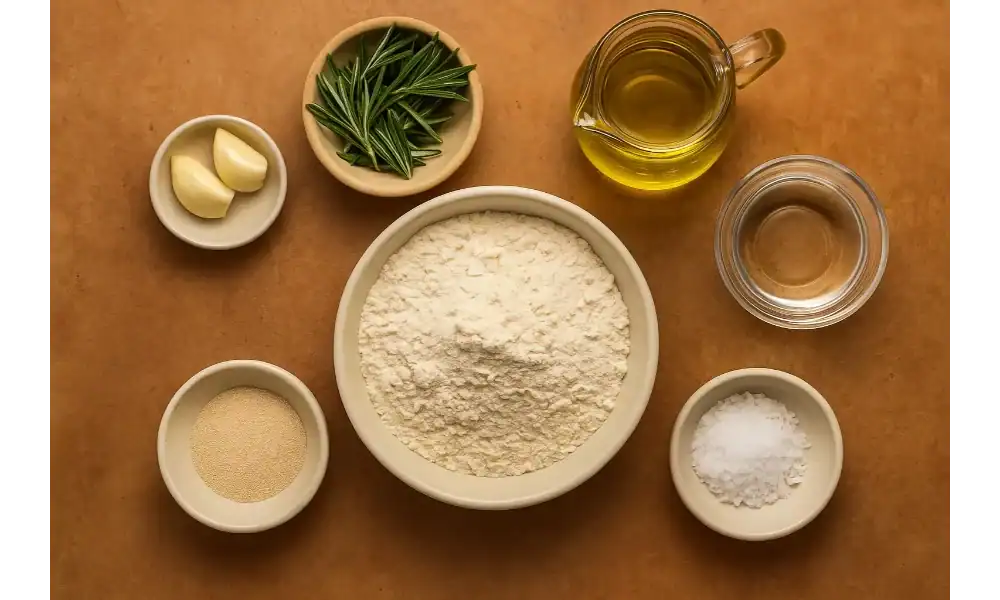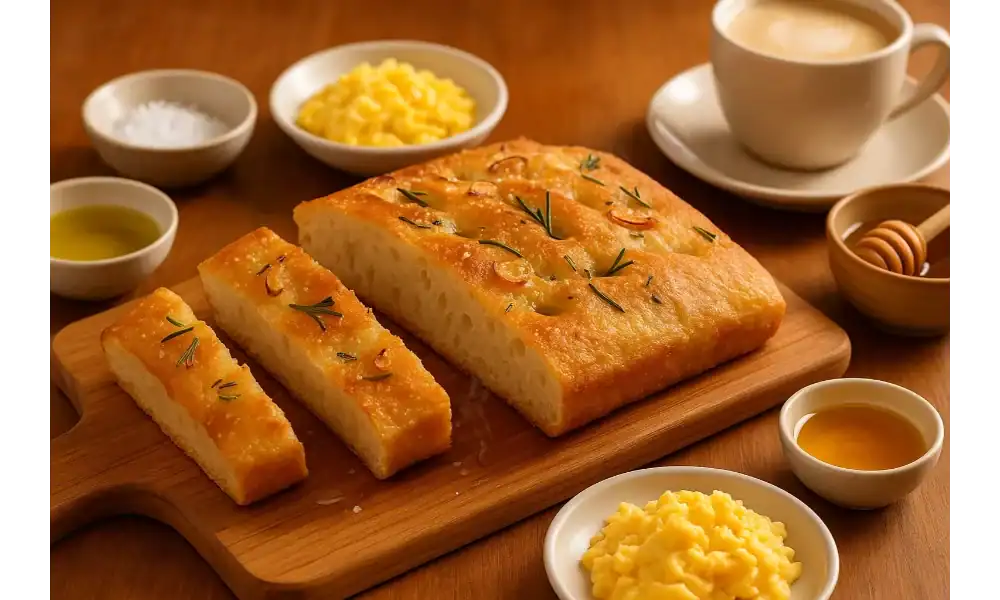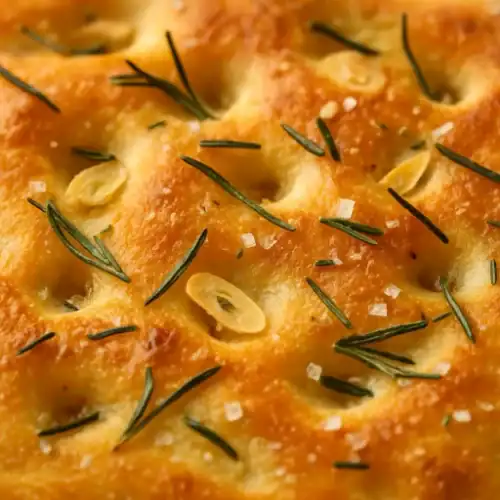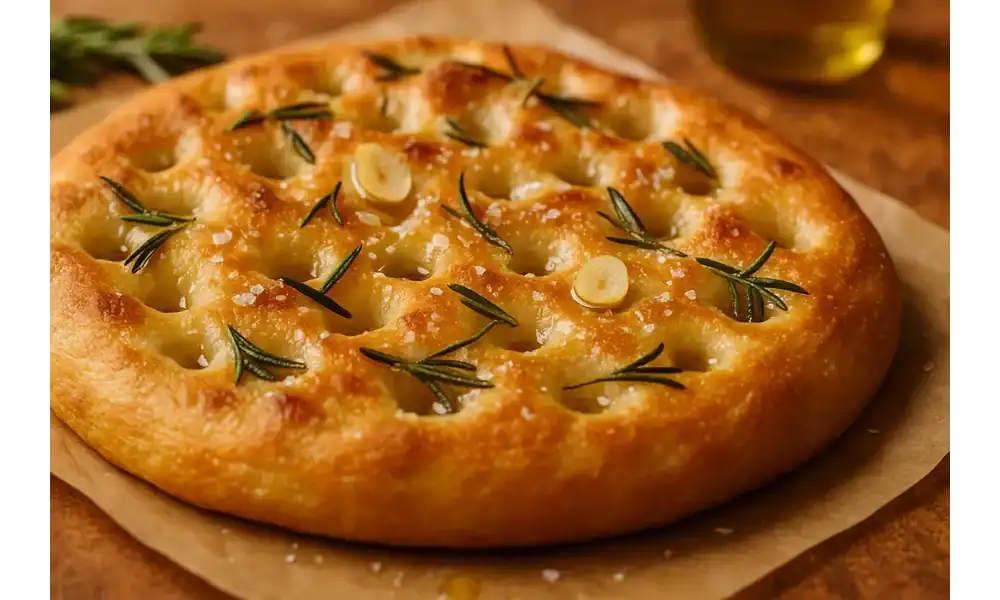Introduction
Golden, crisp edges. A soft, airy center. The first bite of this garlic rosemary focaccia fills the air with the rich aroma of fresh rosemary and warm olive oil. It’s the kind of bread that makes any meal better — perfect with soups, salads, or even as a sandwich base.
This Italian focaccia recipe comes straight from the heart of Mediterranean kitchens, where simple ingredients create incredible flavor. The secret lies in good olive oil, a touch of sea salt, and fresh garlic that turns the crust beautifully fragrant. Each bite gives you a mix of crunch and chew, with the deep taste of rosemary that lingers.
If you’ve never baked bread before, don’t worry. This easy focaccia bread recipe is made for beginners. You don’t need special tools or experience — just a bowl, a baking pan, and your hands. I’ll guide you through every step so you can bake a golden, bakery-style focaccia right at home.
Once you try it, you’ll see why this bread has been loved in Italy for centuries. It’s simple, rustic, and full of flavor. Let’s dive in and make your kitchen smell like an Italian bakery today.
There are different ways to make this focaccia bread:
How to Make the Best Italian Focaccia Bread at Home
Ciabatta vs. Focaccia: Which Italian Bread Is Best for Your Recipe?
What Makes Garlic Rosemary Focaccia So Irresistible
1. The Perfect Balance — Crispy Crust, Soft Airy Center
Every great garlic rosemary focaccia starts with balance. The crust turns golden and crisp while the inside stays light and fluffy. Each bite gives you crunch first, then a soft, chewy center that melts with olive oil and herbs. That’s what makes it impossible to stop eating.
2. Why Olive Oil and Sea Salt Are the Secret to Authentic Flavor
Good olive oil brings flavor and texture to focaccia. It soaks into the dough and creates that signature golden edge. Then comes the flaky sea salt — it lifts every bite and adds a little sparkle to the crust. Together, they turn a simple bread into an authentic Italian focaccia masterpiece.
3. The Role of Garlic and Rosemary in Classic Italian Baking
Garlic and rosemary are the heart of this bread. Garlic gives warmth and depth, while rosemary adds a fresh, pine-like aroma that fills the kitchen. In Italy, bakers often use these two to flavor doughs because they bring comfort and tradition to every slice.
4. Traditional vs. Modern Focaccia Styles (Liguria to Your Kitchen)
In Liguria, the birthplace of focaccia, bakers make it thin, salty, and crisp. Modern versions, like this easy focaccia bread, are thicker and softer, baked right at home. Both are delicious — one tastes like the sea breeze, the other like warm family comfort.
5. When and How to Serve It — Appetizers, Sides, or Sandwiches
You can serve garlic rosemary focaccia in many ways. Slice it warm for an appetizer, pair it with soup or salad, or use it as the base for sandwiches. It fits every meal and always brings that cozy, homemade touch.
Ingredients You’ll Need (and Why They Matter)

1. Flour Choices: Bread vs. All-Purpose — Texture Differences Explained
Flour decides how your garlic rosemary focaccia feels when you bite it. Bread flour gives a chewier and more elastic texture because it has more gluten. All-purpose flour makes it softer and a bit lighter. If you want a bakery-style focaccia, mix both. That blend gives you the perfect balance — crisp edges and a soft, airy crumb.
2. Yeast & Sugar: Getting the Perfect Rise
Good focaccia needs a strong rise. Active dry yeast or instant yeast both work well. A pinch of sugar helps feed the yeast and makes the dough rise faster. Keep your water warm, not hot, so the yeast stays alive and active. That’s how you get a light, fluffy focaccia instead of a dense loaf.
3. Garlic & Rosemary: Fresh vs. Dried — Flavor Intensity Tips
Fresh garlic and rosemary give bold, rich flavor that dried ones can’t match. Mince the garlic finely and chop the rosemary leaves before mixing. If you only have dried herbs, use a smaller amount — they taste stronger. This mix of garlic warmth and rosemary aroma is what makes your focaccia unforgettable.
4. Olive Oil: Why Extra-Virgin Matters for Focaccia’s Signature Taste
Extra-virgin olive oil is the soul of this Italian focaccia recipe. It adds flavor, gives the crust its golden color, and keeps the inside moist. Use it in the dough, drizzle it before baking, and brush it again when it’s hot from the oven. More oil means more flavor and shine.
5. Flaky Sea Salt: The Finishing Touch for Authentic Italian Texture
Finish your focaccia with flaky sea salt. Those small crystals melt slightly as the bread bakes and create tiny bursts of flavor. It’s simple, but it makes a big difference. This final touch turns your bread from homemade to truly authentic Italian focaccia.
Step-by-Step: How to Make Garlic Rosemary Focaccia
1. Step 1: Mix and Proof the Dough (Hydration Secrets)
Start by mixing flour, yeast, salt, water, and a generous drizzle of olive oil. Use warm water to wake up the yeast. The dough should feel sticky and soft — that’s a good sign of proper hydration. Don’t add too much flour; focaccia dough needs moisture to stay airy. Let it rest for about 10 minutes, then mix again until smooth. Cover the bowl and let it sit until the dough doubles in size.
2. Step 2: Let It Rise — Bulk Fermentation Explained
Now the magic begins. Leave the dough in a warm spot for one to two hours. During this time, it develops flavor and structure. You can stretch and fold it once or twice to build strength. When the dough becomes light and bubbly, it’s ready. This step gives your garlic rosemary focaccia that soft, pillowy crumb.
3. Step 3: Dimpling Technique and Adding Toppings
Drizzle olive oil over a baking pan, then spread the dough gently with your hands. Press your fingertips into it to make small dimples — that’s the classic focaccia look. Sprinkle chopped garlic, fresh rosemary, and flaky sea salt on top. The dimples help hold the olive oil and toppings in place while baking.
4. Step 4: Baking for Golden Perfection (Temperature + Time)
Preheat your oven to 220°C (425°F). Bake for 20 to 25 minutes until the top turns golden brown and crisp. The center should feel light and springy when you press it. For a deeper flavor, bake it a few minutes longer until the edges caramelize.
5. Step 5: Cooling and Brushing with Garlic-Infused Olive Oil
Remove the focaccia from the oven and let it cool for a few minutes on a rack. Then brush it with garlic-infused olive oil while it’s still warm. This adds shine and extra flavor. Slice and serve your easy focaccia bread fresh — it’s best enjoyed warm, straight from your kitchen.
Tips, Variations, and Topping Ideas
1. Make-Ahead Options — Overnight Dough or Same-Day Rise
You can prepare your garlic rosemary focaccia the night before or bake it the same day. For overnight dough, let it rise slowly in the fridge. This gives deeper flavor and better texture. If you’re short on time, let it rise for two hours at room temperature. Both ways work, but the cold rise adds that bakery-style taste.
2. Flavor Upgrades — Sun-Dried Tomato, Caramelized Onion, or Olives
Once you master the base, try new flavors. Add sun-dried tomatoes for a tangy kick, caramelized onions for sweetness, or olives for a salty bite. You can even mix herbs like thyme or basil for extra aroma. These toppings make your easy focaccia bread look beautiful and taste even better.
3. Sweet Focaccia Twist — Add Honey and Grapes
Want something different? Turn your bread into a sweet focaccia. Drizzle honey over the dough and top it with fresh grapes or figs before baking. The fruit caramelizes in the oven, while the honey adds a golden glaze. It’s perfect for brunch or dessert and still keeps that light, chewy texture.
4. Common Mistakes to Avoid (Dense Dough, Underproofing)
Avoid adding too much flour or skipping the rise time. Both make the dough heavy and dry. Let it rest long enough so the yeast can do its job. Also, use enough olive oil — it keeps the crumb moist and gives that crisp, golden crust every Italian focaccia recipe needs.
5. Gluten-Free and Vegan Adaptations
You can easily make vegan focaccia by using plant-based toppings and skipping honey. For a gluten-free version, use a blend of rice flour and tapioca starch with a bit more water. The result is still light, soft, and full of garlic and rosemary flavor.
Serving, Storage, and Pairing Suggestions

1. How to Serve Focaccia (Warm, Toasted, or as Sandwich Bread)
Serve your garlic rosemary focaccia warm, right after baking. The crust stays crisp, and the inside stays soft and fragrant. You can also toast it lightly for breakfast or slice it in half for a focaccia sandwich. Its chewy texture makes it perfect for holding fillings like grilled veggies, cheese, or roasted chicken.
2. Pair with Soups, Salads, or Cheese Platters
This Italian focaccia bread goes well with many dishes. Dip it in olive oil and balsamic vinegar, or enjoy it beside tomato soup, creamy broccoli soup, or fresh green salads. It also pairs beautifully with a cheese board — try mozzarella, brie, or aged parmesan for a simple yet elegant mix.
3. Reheating and Storage (Room Temp vs. Freezing)
Keep leftover focaccia at room temperature for up to two days. Wrap it in foil or store it in an airtight bag to keep it soft. For longer storage, freeze it. Just wrap the slices tightly and reheat them in the oven at 180°C (350°F) for about 8 minutes. This keeps the crust crisp and the middle moist.
4. How Long Focaccia Stays Fresh — Best Practices
Homemade easy focaccia bread stays fresh for two to three days if stored properly. Avoid putting it in the fridge, as it dries out faster. Instead, keep it in a cool, dry place. Before serving again, warm it in the oven to bring back the fresh-baked flavor.
5. Creative Leftover Ideas — Croutons or Panini Base
Don’t throw away leftover garlic rosemary focaccia. Cut it into cubes, drizzle with olive oil, and toast them into flavorful croutons for salads or soups. You can also use thick slices as a base for panini sandwiches. Every piece still delivers that crispy, garlicky bite you love.
Golden Garlic Rosemary Focaccia

Golden Garlic Rosemary Focaccia
Ingredients
Method
- Activate the yeast: Mix warm water with sugar and yeast. Let it sit 5 minutes until foamy.
- Make the dough: Add flour and salt. Stir until combined. Drizzle 1 Tbsp olive oil over the top. Mix until sticky and soft.
- First rise: Cover the bowl and let the dough rise 1 hour in a warm spot until doubled.
- Prepare the pan: Brush a 9×9-inch (23×23 cm) pan with olive oil. Transfer the dough, stretch it gently to fit, and let it rest 20 minutes.
- Add toppings: Dimple the dough with your fingertips. Drizzle 2 Tbsp olive oil on top, then scatter garlic, rosemary, and flaky salt.
- Bake: Bake in a preheated oven at 425 °F (220 °C) for 20–25 minutes, until the top is golden and crisp.
- Finish and serve: Brush the warm focaccia with a bit of olive oil. Cool for 10 minutes, slice, and serve warm.
FAQs
1) What flour is best for garlic rosemary focaccia?
Use bread flour for a chewier crumb. Use all-purpose for a softer bite. Mix both for balance.
2) Can I make focaccia without a mixer?
Yes. Mix with a spoon, then use stretch-and-fold. This keeps the dough airy.
3) Do I need fresh rosemary and garlic?
Fresh gives brighter flavor. Dried works too. Use less if dried since it tastes stronger.
4) How long should the dough rise?
Let it double in size. This usually takes 1–2 hours at room temp.
5) Why is my focaccia dense?
You added too much flour or cut the rise short. Keep the dough wet and let it proof fully.
Conclusion
Garlic rosemary focaccia proves that simple ingredients can create something amazing. With flour, olive oil, garlic, and rosemary, you can make bread that’s crisp on the outside and soft inside. It fits every meal — serve it warm with soup, salad, or use it as a sandwich base.
This easy focaccia bread is more than just a side; it’s a recipe you’ll keep coming back to. Once you bake it, you’ll see how quick, fun, and rewarding homemade bread can be. The golden crust, the aroma of rosemary, and the flavor of garlic make every bite special.
So, roll up your sleeves and give this Italian focaccia recipe a try. You’ll fill your kitchen with warmth and the smell of freshly baked bread.
If you loved this recipe, check out my Easy Baked Ziti as it pairs beautifully with focaccia!
For more recipes, try our:
- Seafood Showdown: Calamari vs Squid – Which One Wins on the Plate?
- How to Make the Best Mississippi Pot Roast: Tender, Juicy, and Easy
- 10 Irresistible Shrimp Pasta Recipes You’ll Want to Make Tonight
- How to Achieve the Perfect Baked Mac and Cheese Every Time
- Chickpea and Avocado Wrap with Fresh Herbs and Cucumber

